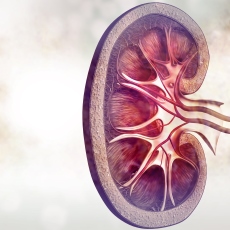
You have two kidneys, each about the size of your fist. They are near the middle of your back, just below the rib cage. Inside each kidney there are about a million tiny structures called nephrons. They filter your blood. They remove wastes and extra water, which become urine. The urine flows through tubes called ureters. It goes to your bladder, which stores the urine until you go to the bathroom.
Most kidney diseases attack the nephrons. This damage may leave kidneys unable to remove wastes. Causes can include genetic problems, injuries, or medicines. You have a higher risk of kidney disease if you have diabetes, high blood pressure, or a close family member with kidney disease. Chronic kidney disease damages the nephrons slowly over several years. Other kidney problems include:
- Kidney Diseases (National Library of Medicine)You have two kidneys, each about the size of your fist. They are near the middle of your back, just below the rib cage. Inside each kidney there are about ...
- Kidney Failure (National Library of Medicine)Healthy kidneys clean your blood by removing excess fluid, minerals, and wastes. They also make hormones that keep your bones strong and your blood healthy. ...
- Kidney Cancer (National Library of Medicine)You have two kidneys. They are fist-sized organs on either side of your backbone above your waist. The tubes inside filter and clean your blood, taking out ...
- Dialysis (National Library of Medicine)When your kidneys are healthy, they clean your blood. They also make hormones that keep your bones strong and your blood healthy. When your kidneys fail, ...
- Kidney Transplantation (National Library of Medicine)A kidney transplant is an operation that places a healthy kidney in your body. The transplanted kidney takes over the work of the two kidneys that failed, ...
- Kidney Tests (National Library of Medicine)You have two kidneys. They are fist-sized organs on either side of your backbone above your waist. Your kidneys filter and clean your blood, taking out waste ...
- Renal coloboma syndrome (also known as papillorenal syndrome) is a condition that primarily affects kidney (renal) and eye development. People with this condition ...
- Action myoclonus–renal failure (AMRF) syndrome causes episodes of involuntary muscle jerking or twitching (myoclonus) and, often, kidney (renal) disease. Although ...
- Renal tubular acidosis with deafness is a disorder characterized by kidney (renal) problems and hearing loss. The kidneys normally filter fluid and waste products ...
- Renal hypouricemia is a kidney (renal) disorder that results in a reduced amount of urate in the blood. Urate is a byproduct of certain normal chemical reactions ...



